We’ve all been there, hypnotized by the hum of the sewing machine, lost in a sea of delightful fabrics, only to be abruptly brought back to reality by the sudden “ouch!” That, my dear friends, is the perfect segue into today’s topic: Sewing safety rules. As the old saying goes, “A stitch in time saves nine,” but let’s add “…and saves nine fingers too!”
When you first began to learn to sew, you were likely extraordinarily careful around needles and sharp tools. Whether you were on your beginner’s sewing machine or practicing how to sew by hand, you instinctively knew what to watch out for!
Don’t fret; I’ll keep this light-hearted because safety doesn’t have to be a somber sermon! Let’s dive into the ten sewing safety rules to keep you and your digits intact!
Rule 1: Respect Your Tools
Your supplies for sewing are like friends, and good friendships require time, care, and respect. Now, I’m not suggesting you need to have heart-to-heart talks with your seam ripper (although, who am I to judge?), but you do need to look after your tools to keep them – and you – in good working order.
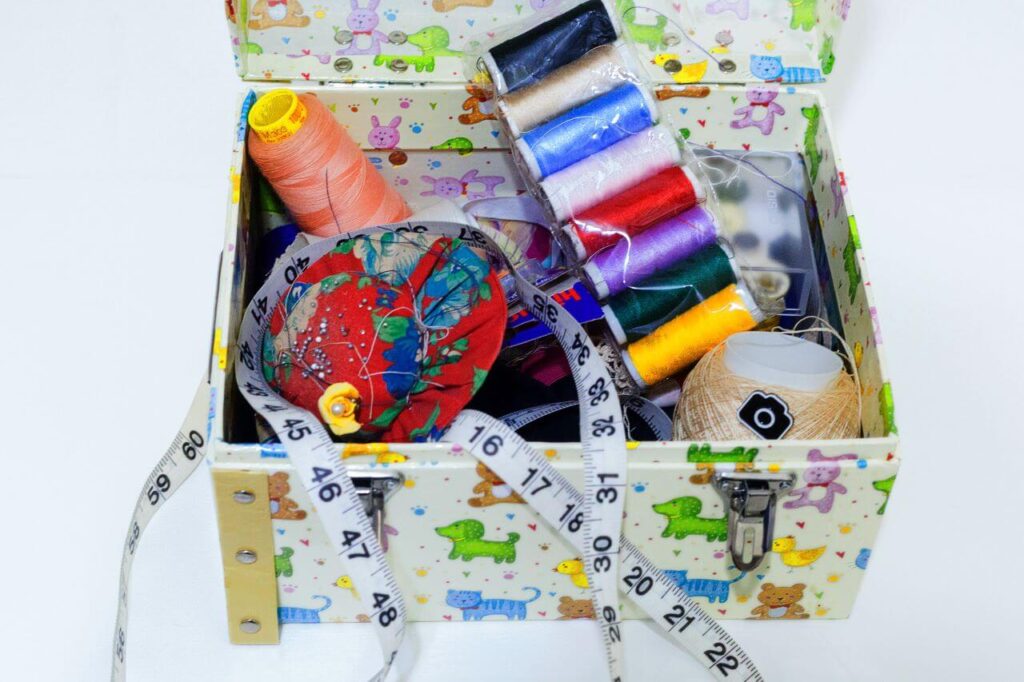
Firstly, keeping your tools clean is a must. Over time, dust and grime can build up on your tools, affecting their performance. For instance, a dirty sewing machine may start skipping stitches, breaking threads, or making unsettling sounds. Learn the parts of a sewing machine, and give it a regular cleaning. This keeps it running smoothly and allows you to check for any other issues like loose screws or worn parts.
Your needles and blades also deserve a little TLC. Dull needles make your job harder and pose a safety risk as they’re more likely to slip or break. Make sure to replace your sewing machine needles after every large project or after 6-8 hours of sewing. Keep your fabric shears and rotary cutter blades sharp; not only will they cut your fabrics more cleanly, but they’ll also be safer to use.
Rule 2: No Need for Speed
Unless you’re auditioning for the next “Fast & Furious: Sewing Edition” (and really, who would want that?), there’s no need for speed when sewing. Faster isn’t always better.
While we may be impressed by the lightning speed of professional sewists, remember, they’ve spent years (maybe even decades) honing their skills. If you’re a beginner or intermediate sewist, going too fast can lead to mistakes, frustration, and even accidents.
Sewing at high speed, especially when using a sewing machine, can result in uneven stitches, puckered fabric, or worse, a broken needle. Let’s not even get started on the potential injury a snapped needle can cause! It’s better to maintain a slow, steady pace that allows you to have complete control over your work. This helps ensure your stitches are even and your seams are straight.
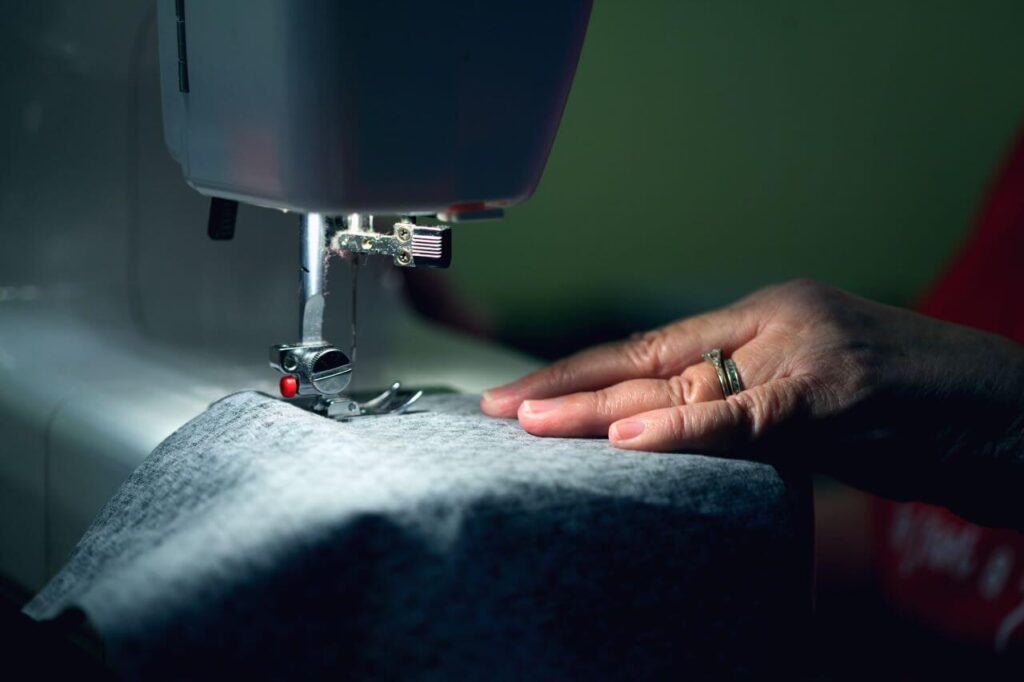
When hand sewing, rushing can lead to uneven stitches, punctured fingers, or overlooked mistakes that may require the dreaded seam ripper later. Taking your time allows you to place each stitch precisely and saves you the trouble of redoing your work.
Rushing through your project can also lead to cutting corners on safety measures. Some fabric types are rather slippery, and you might be tempted to leave pins in the fabric while sewing or to skip the crucial step of pressing your seams. These shortcuts not only affect the quality of your final product but can also lead to accidents.
Rule 3: Mind Your Pins and Needles
Oh, pins. These tiny, sharp objects are essential tools for every sewist. They help to hold our fabrics in place, ensure accurate cutting, and make our sewing lives a whole lot easier. But they also have a knack for ending up where they don’t belong – in our fingers, on the floor, or even in our sewing machines.
When pinning fabric, make sure your fingers are well clear of the pin’s path. Use a thimble if you’re having difficulty pushing a pin through thick fabric; don’t try to force it and risk the pin slipping and stabbing your finger.
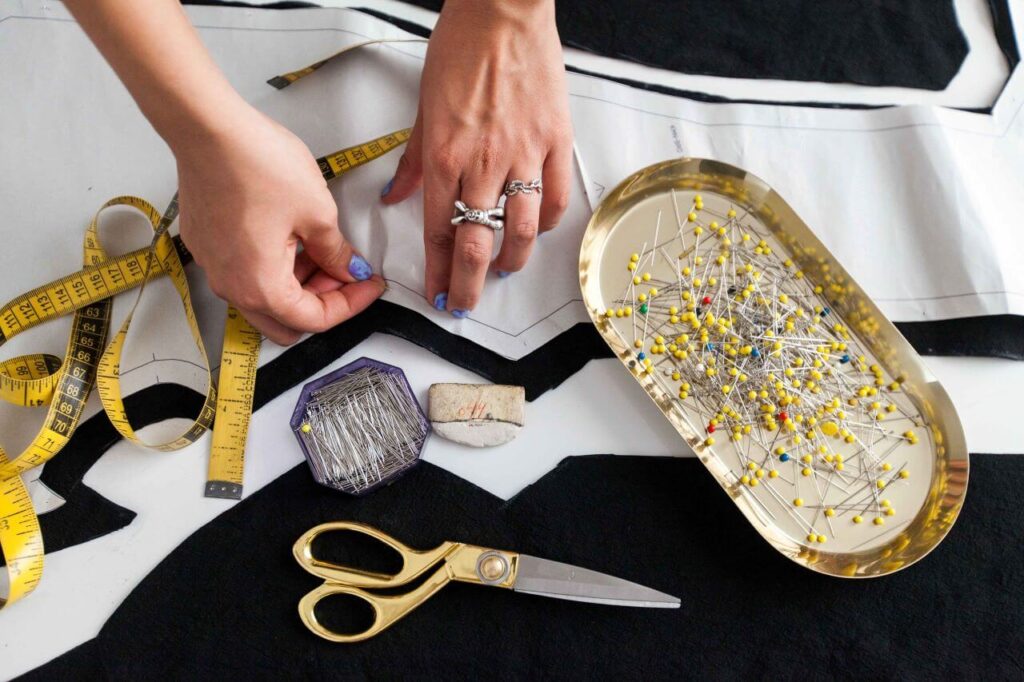
Leaving pins in fabric while sewing might seem like a good way to ensure everything stays in place, but it’s a dangerous game to play. Pins can break needles, damage your sewing machine, or get flung at high speed if your machine hits them. Always remove pins before they reach your sewing machine needle. Using a seam ripper or tweezers can help safely remove pins without slowing down your sewing too much.
Rule 4: Keep It Clean
A tidy workspace isn’t just about aesthetics – although, who doesn’t love the sight of a neat and organized sewing room? It’s also a critical element of sewing safety. A clean, uncluttered area makes for a more efficient, productive, and, most importantly, safer sewing experience.
Start with your sewing machine. Regularly clean out the bobbin area and remove any accumulated lint or threads. This can help prevent your machine from jamming or malfunctioning, reducing the risk of needle breaks or other sewing mishaps.
Keeping your fabric and other materials organized also helps to avoid accidents. Loose fabric scraps can easily become a tripping hazard. Plus, it’s far easier to work when you know exactly where each piece of fabric or essential tool is.
Don’t forget about your floor! It’s not just about avoiding a painful encounter between a pin and your bare foot. Spilled liquids, power cords, and even offcuts of fabric can cause you to trip and fall. Tripping over a rogue spool of thread can turn a relaxing sewing session into an impromptu acrobatics routine. And let’s be real; we’re sewists, not gymnasts!
Rule 5: Lights, Camera, Action!
Sewing is a visual craft. It requires keen eyesight and attention to detail. But squinting over dark fabric or straining your eyes to thread a needle isn’t just frustrating – it’s also bad for your eyes and can even lead to headaches or migraines. So let’s shed some light on the importance of good lighting in your sewing space!
First, aim for a combination of natural and artificial light in your sewing area. Natural light provides a broad spectrum of colors, making it easier to match threads and fabrics accurately. However, since we can’t control the amount or consistency of natural light, it’s essential to also have good-quality artificial light sources.
Don’t limit yourself to just one light source. Having multiple lights allows you to adjust the lighting based on the task at hand. For example, an overhead light can illuminate your entire workspace, while a desk lamp with a flexible arm can be positioned to provide focused light for detailed work like threading needles or unpicking stitches.

Now, about that ‘Camera’ bit. This doesn’t mean you need to start filming your sewing sessions (unless you want to!). Instead, think of your eyes as the camera. Just as a camera captures better images with good lighting, your eyes can see better and strain less when they have sufficient light.
Good lighting is not just about comfort, though. It’s also a crucial safety measure. Proper lighting makes you less likely to make mistakes like cutting a pattern incorrectly, stitching your finger instead of your fabric, or missing a stray pin. So unless you’re trying to create a moody noir film, turn up those lights! Your eyes and your stitches will thank you.
Rule 6: The Chair Affair
Sewing is often a sit-down activity, and if you’re uncomfortable, you won’t be able to sew for long stretches. Poor posture can lead to back pain, neck strain, and other health issues over time. That’s why choosing the right chair for your sewing adventures is so important.
First, your chair should be the right height for your sewing table. Your arms should be able to rest comfortably at a 90-degree angle when you’re sewing. If your chair is too low, you’ll hunch over, straining your neck and back. If it’s too high, you’ll have to lift your arms unnaturally, causing shoulder tension. Adjustable chairs are a fantastic solution since you can raise or lower them to the perfect height for you.
But the correct height is just the start. Look for a chair that supports your lower back – this will help you maintain good posture during those long sewing sessions. Ergonomic chairs are designed with comfort and posture in mind, making them an excellent choice for sewists.

Next, consider the cushioning. After all, you’ll be spending a lot of time in this chair. A good cushion can make the difference between finishing your sewing project happily and hobbling away with a sore bottom. Even if you’re sewing on a budget, this is worth spending the money on. Choose a chair with enough cushioning to keep you comfortable but not so soft that you sink into it.
There are many emotional and mental sewing benefits, but they’re useless if you neglect your physical needs! Invest in a good chair that supports your back and keeps you comfy. Because nothing screams “old” like groaning every time you get up!
Rule 7: Take a Break, Have a Kit-Kat!
Remember to take breaks regularly. Stretch your legs, rest your eyes, hydrate, and maybe sneak in a chocolate bar (or two!). Sewing is fun, but it’s not a hostage situation. You’re allowed to walk away and come back later.
When you’re engrossed in a sewing project, it’s easy to lose track of time. One minute you’re pinning fabric pieces, and the next thing you know, hours have passed. But sewing, like any other activity that requires concentration and physical effort, can be both mentally and physically taxing. That’s where the importance of taking regular breaks comes in.
Firstly, sitting for long periods can strain your back, neck, and shoulders, leading to stiffness, discomfort, and even long-term health issues. Standing up, stretching, or moving around every 30 minutes or so can help to alleviate this. Simple activities like walking to get a drink of water, doing a quick yoga stretch, or just standing and shaking out your limbs can do wonders.
Taking breaks isn’t just about physical health, though. It’s also about maintaining your mental sharpness. Concentrating on a task for an extended period can lead to mental fatigue, which can result in common sewing mistakes, decreased productivity, or even accidents. A quick break can give your brain time to rest and recharge, keeping your mind sharp and alert.
Now, you might be thinking, “But I’m in the flow! I don’t want to break my concentration.” Don’t worry; taking a break doesn’t mean losing your momentum. You can come right back to your seams and sewing darts.
Stepping away from your work for a short while can provide a fresh perspective when you return. You might notice a better way to do a certain stitch or realize that the color thread you’re using isn’t quite right.
Rule 8: Practice Safe Cutting
Cutting fabric is one of the first steps in the sewing process, and it can also be one of the most hazardous if not done correctly. Sharp scissors and rotary cutters are fantastic tools, but they demand respect and caution to avoid accidents.
Always cut away from your body when using a rotary cutter or scissors. Trust me; a sewing project shouldn’t include a pint of your own blood. Also, keep your fingers clear of the path of the blade. After all, you’re aiming to cut fabric, not your digits!
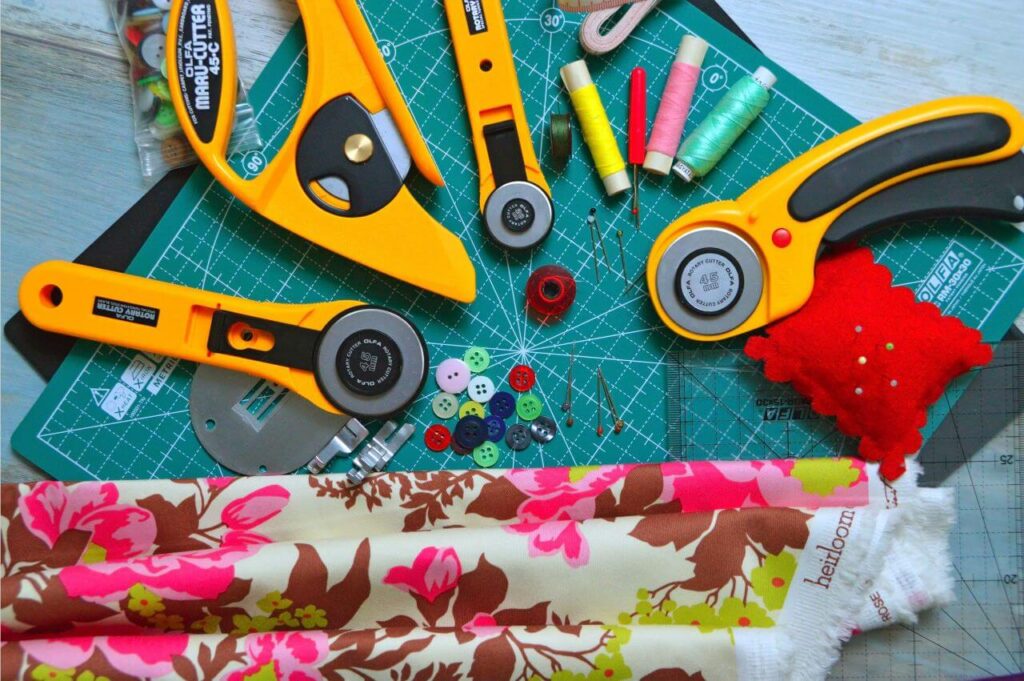
Next, always use the right tool for the job. Fabric scissors and rotary cutters are designed specifically for cutting fabric. They’re sharp, precise and make the job easier and safer. Using dull or inappropriate tools can lead to jagged cuts, damaged fabric, and an increased risk of the tool slipping and causing injury.
Always engage the safety lock for rotary cutters when you’re not actively cutting. It might seem like a nuisance to constantly lock and unlock your cutter, but this simple habit can prevent serious injuries. And just like with scissors, always cut away from your body.
Use a proper cutting mat. Cutting mats not only protect your table surface; they also keep your tools sharp and provide a safer cutting surface. They can help to grip your fabric, reducing the risk of the material, and therefore the cutter, slipping.
Rule 9: Play it Cool
Be careful with your iron. You’d be surprised how many sewists have horror stories about iron-related injuries. Always use it with caution, and never leave it unattended when it’s hot. Remember, wrinkles on fabric are fixable; burns, not so much.
Firstly, let’s tackle the obvious. An iron is hot, really hot. This means that you should always handle it with care, making sure to avoid touching the metal plate and keeping your fingers well away from the steam vents. Steam burns are painful and surprisingly easy to get if you’re not careful.
Always place your iron back on its stand or heel when you’re not actively using it. Leaving a hot iron face down on your ironing board (or worse, on your fabric) is a fire risk and can also damage your ironing board cover or your precious fabric.
Remember to switch off your iron as soon as you’re done using it. We’ve all had that moment of panic when we leave the house and can’t remember if we switched off the iron. Avoid this by making it a habit to turn off the iron as soon as you finish. If you’re someone who often forgets, consider getting an iron with an auto-off feature for an extra layer of safety.
Rule 10: Keep Your Eyes on the Prize
When I talk about “keeping your eyes on the prize” in sewing safety, I mean maintaining focus and awareness throughout your sewing process. The “prize” isn’t just your finished product (although that’s always a thrilling sight) but also a successful, accident-free sewing session.

Your eyes should always be on the work when you’re sewing, particularly with a machine. Distractions can lead to mistakes or accidents. Sure, the latest episode of that popular show might be enticing, but it’s not worth a sewing mishap. Consider listening to audiobooks or podcasts if you need some background noise – these can keep you entertained while allowing you to focus fully on your sewing. There will be plenty of time for Netflix later!
Sewing requires concentration, precision, and an eye for detail. Whether you’re threading a needle, cutting a pattern, or running fabric through your sewing machine, these tasks require your full attention. Distractions can lead to mistakes and, in the worst cases, accidents.
Cutting is another task that requires total focus. When using sharp scissors or a rotary cutter, it’s crucial to watch where the blade is going. This isn’t the time to watch TV or talk to a friend. Remember, the cutter doesn’t care what it’s slicing through—fabric, paper, or, heaven forbid, your fingers—it’s all the same to the blade.
Even seemingly innocuous tasks, like pinning fabric or threading a needle, require a keen eye. A momentary distraction can result in a prick or a poke, which is not only painful but can also cause your project to become stained with blood. It’s always better to take your time and avoid injuries than to rush and risk an accident.
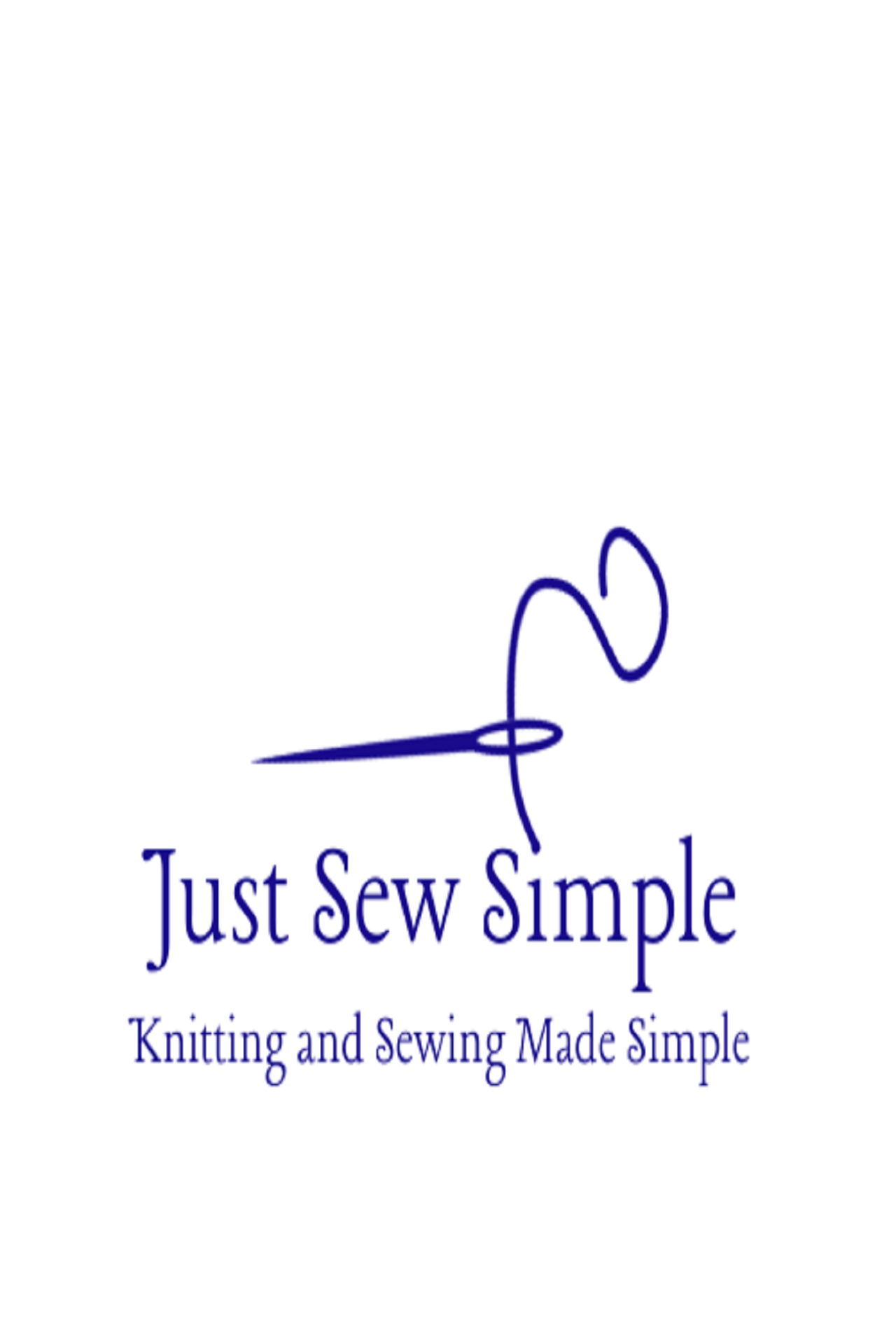
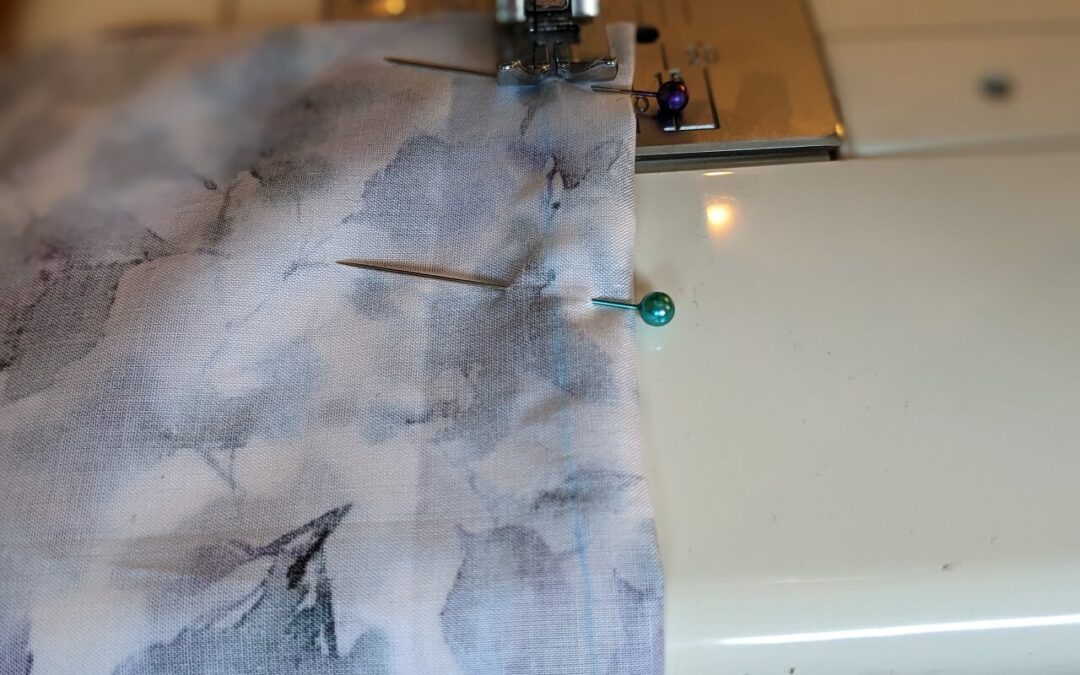
This is a very good reminder and should be looked at every sew often.
Thank you for putting a boring subject into meaningful remedies.